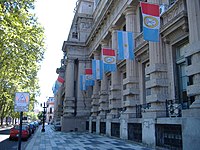Rosariazo
The Rosariazo (Spanish pronunciation: [rosaˈɾjaso]) was a protest movement that consisted in demonstrations and strikes, in Rosario, province of Santa Fe, Argentina, between May and September 1969, during the military dictatorial rule of de facto President General Juan Carlos Onganía.
On 15 May the University of Corrientes increased the price of food tickets in its cafeteria fivefold, and the ensuing protest ended up with one student, Juan José Cabral, killed by the police.
On 29 May there was a general strike in the city of Córdoba, which brought police repression and a civil uprising, an episode later termed the Cordobazo.
The May Revolution commemoration on 25 May was marked by the refusal of many priests to celebrate the traditional Te Deum in Rosario and nearby towns.
In the celebration of the National Flag Day (20 June), President Onganía customarily visited Rosario and was declared persona non grata.
After a few months of relative calm, Rosario university students started a series of protests and memorials commemorating the victims of state repression on 7 September 1969.
Colonel Leopoldo Galtieri (who would later become president of the military regime in 1981) was among the Army personnel involved in the repression.
The power of President Onganía was weakened by the Rosariazo and the Cordobazo, to the point that the dominant military faction asked him to resign, which he refused to do.



